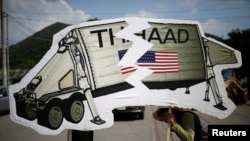Questions have arisen about the future of the U.S.-South Korea security alliance as the nations take different approaches to North Korea, despite the fact the decades-long relationship remains robust right now, experts say.
“The U.S. and South Korea are aligned for now because North Korea is not playing ball, it’s not accepting South Korean requests for dialogue,” Sue Mi Terry, a former CIA analyst and director for Korea, Japan and Oceanic Affairs at the U.S. National Security Council, told VOA’s Korean Service. “But that could change of course.”
Questions about the strength and resilience of the Washington-Seoul relationship loomed large after South Korean President Moon Jae-in declared August 15 in a televised speech that there will be no military action on the Korean peninsula without his government’s approval.
Moon made his statement days after U.S. President Donald Trump suggested the possibility of “fire and fury like the world has never seen” if North Korea continues on its current path of weapons development.
100th day in office
During Thursday’s news conference marking his 100th day in office, the liberal South Korean president reiterated his stance, saying “there will never be another war on the Korean peninsula,” in what appeared to some to be a direct rebuke of Trump’s stance, which keeps the military option on the table.
“There is a potential for serious differences between Washington and Seoul,” said Alexander Vershbow, who was U.S. ambassador to Seoul from 2005-2008. “But right now I think the administration is in tune with President Moon Jae-in in trying to convince the North Koreans to halt further provocations.”
David Straub, a former U.S. diplomat who is now a fellow at the Sejong Institute, a research organization near Seoul, said with Moon advocating a policy of engagement and dialog, it is already difficult for Washington to work with Seoul to influence Pyongyang’s weapons programs. In what appeared to be another effort to resume dialog with the North, Moon said Thursday he was considering sending an envoy to North Korea.
“Since all of Washington -- both Democrats and Republicans -- stopped supporting such an approach a decade ago, it would be sensitive and difficult enough already for Washington and Seoul to coordinate closely on North Korea policy,” Straub said.
On the possibility of resuming talks with Pyongyang, State Department spokeswoman Heather Nauert said Wednesday there should first be goodwill gestures from North Korea – stopping nuclear testing, ballistic missile testing and destabilizing activities in the region.
“The United States is willing to sit down with North Korea and have a conversation,” Nauert said. “But we are not anywhere near that point yet.”
Uncertainties ahead
The risks to the U.S.-South Korea alliance could come from uncertainties surrounding the future of the U.S. Terminal High Altitude Area Defense (THAAD)missile system, now deployed in South Korea, and the possible resumption of efforts for inter-Korean economic cooperation, such as the Kaesong Industrial Complex, said Terry, who is currently managing director for Korea at the Bower Group Asia consultancy.
“If North Korea, for example, reaches out to South Korea and the Moon administration decides to pursue that path of engagement and make a different decision on THAAD or open Kaesong,” Terry said, "then of course, there would be huge diversions and problems and strains to the alliance.”
Rand Corporation defense analyst Bruce Bennett underscored that reopening the Kaesong Industrial Complex, a joint Korean factory complex, would be a violation of U.N. sanctions.
Launched in 2004 to enhance cooperation between the two Koreas, the complex reportedly provided more than $100 million a year in wages to some 54,000 North Korean workers and contributed almost $2 billion in trade for Pyongyang before it was closed in February 2016 after Pyongyang’s nuclear test and long-range rocket launch.
Ken Gause, director of the International Affairs Group at the Center for Naval Analyses, noted that for now, South Korea “seems to be on the same page with the United States on THAAD” in light of the growing threats emanating from the North, which tested two long-range intercontinental ballistic missiles (ICBM) in July.
But THAAD, Gause said, could be “a future wedge” because China continues to oppose its deployment, insisting that the missile shield would compromise its regional security interests.
“South Korea, after the last ICBM tests by North Korea, really began to fast track the THAAD deployment, which they've been kind of holding up with this kind of environmental survey,” he said. “This is something that obviously China is very concerned about, and we'll continue to try to put pressure on South Korea to back away from that.”










